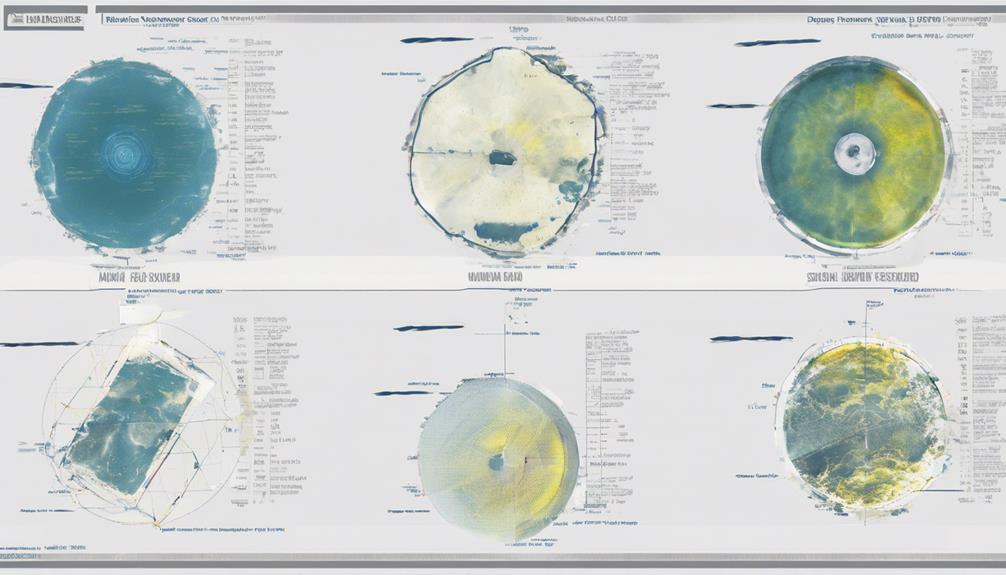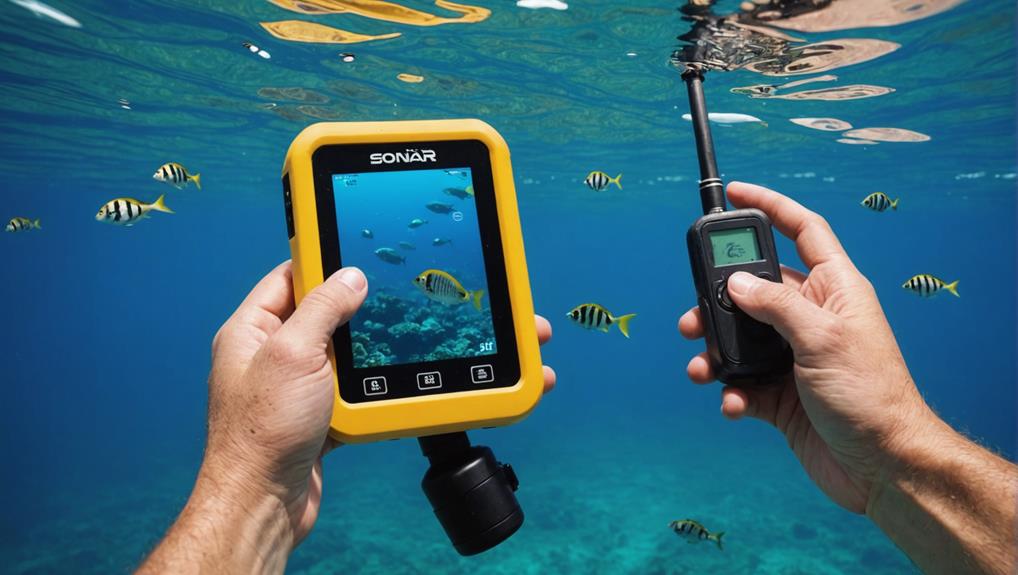When buying a portable underwater sonar device, key features to ponder include frequency, advanced depth sensor technology, power output, screen resolution, and size. You'll want a frequency that suits the water depth you'll be fishing in, with higher frequencies (up to 400 kHz) ideal for shallow water and lower frequencies for deeper water. Ponder the type of sonar you need: echosounders for bathymetry, imaging sonars for seafloor mapping, or portable fish finders with CHIRP sonar. Your device's effectiveness will depend on choosing the right transducer, sonar environment, and power output, so it's vital to understand these components to make an informed decision.
Key Takeaways
- Choose a portable sonar device with the right frequency for your water depth, from 20-400 kHz.
- Consider a device with advanced depth sensor technology for accurate depth readings and water temperature.
- Select a device with a suitable power output, measured in watts, for your fishing needs.
- Opt for a device with a high-resolution screen and sufficient size for clear underwater imaging.
- Consider the type of sonar technology, such as CHIRP or imaging sonar, for your specific fishing requirements.
Key Features to Consider
When selecting a portable underwater sonar device, you'll want to ponder several key features that substantially impact its performance and effectiveness in various underwater environments.
The frequency, ranging from 20-400 kHz, is pivotal, as higher frequencies are better suited for shallow water and lower frequencies for deeper water. This feature is particularly important for a fish finder, as it directly affects the device's ability to detect and display underwater targets.
Advanced depth sensor technology, such as CHIRP sonar technology, combines sonar and GPS data to provide accurate depth readings and water temperature information, making it suitable for both shallow and deep water fishing. Additionally, dual spectrum CHIRP signal provides increased accuracy and reduces interference from other electronic devices.
The power output of the device, measured in watts, is another essential consideration. A higher wattage device can scan deeper and farther, providing you with more exhaustive information about the underwater environment.
You'll also want to weigh the screen resolution and size, as higher resolutions and larger screens provide more detailed and clear images. A high-quality screen will enable you to accurately interpret the data and make informed decisions.
When evaluating a portable underwater sonar device, don't overlook these key features, as they'll profoundly impact the device's overall performance and effectiveness.
Types of Sonar Devices
As you explore portable underwater sonar devices, you'll find that echosounders play a key role in bathymetry, with single beam echosounders providing a single depth measurement point directly below the transducer and multibeam echosounders measuring water depth at many points at once.
You'll also encounter imaging sonars, which collect sonar images of the seafloor and underwater features, including scanning imaging sonars for detailed, high-resolution imaging.
When selecting an imaging sonar, you'll need to decide between scanning imaging sonars for specific areas or objects and side scan sonars for surveying large areas of the seafloor.
For accurate sonar readings, consider portable fish finders with CHIRP sonar technology CHIRP sonar technology that provides higher resolution and accuracy, making it a desirable feature in portable fish finders, and a display size that suits your fishing environment.
Additionally, built-in GPS and transducer technology can also enhance the accuracy and effectiveness of your sonar device.
Echosounders and Bathymetry
Echosounders play a pivotal role in bathymetry, a technique used to map the seafloor and measure water depth in oceans, seas, or lakes.
Using sonar technology, echosounders emit sound waves that travel to the seafloor and bounce back, allowing you to measure the distance in water. This information is essential for understanding the underwater environment and conducting various marine activities.
When choosing an echosounder, you'll come across three main types: single beam, dual-frequency, and multibeam.
Single beam echosounders provide a single depth measurement point directly below the transducer, making them cost-effective, compact, and simple to operate. However, they offer low detail when mapping.
Dual-frequency echosounders send out low and high-frequency waves simultaneously, offering broader operating conditions.
Multibeam echosounders measure water depth at many points at once, providing much more detail and the ability to see the shape of the seafloor and detect objects. As the gold standard for bathymetry, multibeam echosounders are ideal for hydrographic surveying, oceanographic research, and marine resource exploration.
Imaging Sonars
Imaging sonars, commonly used in underwater applications, provide detailed, high-resolution images of specific areas or objects underwater.
You'll find three primary types of imaging sonars, each with unique characteristics and uses.
Scanning imaging sonars are often used on remotely operated vehicles (ROVs) for object detection and navigation. They offer high-resolution imaging of specific areas or objects underwater.
Multibeam imaging sonars, on the other hand, update the image multiple times per second, providing a faster update rate and a view of structures, objects, and the seafloor around the vehicle.
They are ideal for navigation and have a high sonar frequency, resulting in detailed images. However, they're expensive, with prices starting at $12,000, and have a limited distance range of up to 200 meters.
Side scan sonars are commonly used for surveying large areas of the seafloor.
They emit fan-shaped pulses and record the echo response to create slices of an image.
This type of sonar offers a wide beam, enabling you to cover large areas quickly, making them a cost-effective option starting at a few thousand dollars.
Choosing the Right Transducer

When choosing the right transducer for your portable underwater sonar device, you'll need to weigh the type of transducer that suits your boat and fishing needs, such as transom, thru-hull, in-hull, or trolling motor mounts.
You must also select the correct frequency and power output to achieve peak performance, as these factors directly impact the device's ability to detect and display underwater structures.
For example, using a higher frequency option, such as omnidirectional sonar systems, can provide a 360-degree view of the underwater environment, ideal for fishing boats.
Additionally, a narrower vertical beam, like the 6-degree beam in the MAQ Sonars omnidirectional sonar system, can help reduce interference and improve image quality.
Transducer Types Explained
A portable underwater sonar device's effectiveness largely depends on its transducer, so choosing the right type is crucial.
When selecting a transducer for your sonar device, you'll encounter different types that cater to specific needs. Single-frequency transducers operate at a fixed frequency, typically 50 kHz or 200 kHz, and are suitable for specific water depths and fishing conditions.
Dual-frequency transducers, on the other hand, provide more versatility and can be used in a variety of water depths and conditions, as they can switch between frequencies such as 50 kHz and 200 kHz.
CHIRP transducers are another option, emitting a sweeping frequency range, typically between 40 kHz and 240 kHz, to provide high-resolution images and detect fish at greater depths.
In addition to frequency, consider the mounting type: transom-mount transducers are the most common and suitable for boats under 30 feet, while thru-hull mount transducers provide the best performance but require drilling a hole in the hull.
In-hull mount and trolling motor mount transducers are also available, each with their own set of advantages and requirements.
Frequency and Power Selection
Selecting the right frequency and power for your portable underwater sonar device's transducer can profoundly impact its performance and your overall fishing experience.
When choosing a transducer, weigh the type of sonar you'll be using and the environment you'll be fishing in. A higher frequency transducer (192-200 kHz) provides better detail and accuracy in shallow waters (up to 100 feet), while a lower frequency transducer (50 kHz) is better suited for deeper waters (up to 400 feet).
Dual-frequency transducers offer the flexibility of switching between high and low frequencies, making them suitable for both shallow and deep water fishing.
When it comes to fishfinders power, a higher power transducer (up to 1000 watts) is recommended for offshore fishing and deeper waters, while a lower power transducer (100-300 watts) is sufficient for shallow waters and inland lakes.
Every 100 watts of power provides an additional 400 feet of depth on a 50 Hz frequency, so it's crucial to deliberate power and frequency when selecting a transducer.
A frequency-based approach will help you choose the right transducer for your specific needs, ensuring peak performance from your portable underwater sonar device.
Mounting Options Considered
Most portable underwater sonar devices offer multiple mounting options for transducers, giving you several choices to ponder.
When choosing the right transducer mount, you should consider your boat type, fishing style, and personal preference. For boats under 30 feet, a transom mount is a common installation method, offering a balance between performance and cost.
However, if you're willing to drill a hole in the hull, a thru-hull mount provides the best performance, but it's more complex and invasive.
If you have a boat with a thin hull, an in-hull mount is suitable, but it requires a sensitive transducer. Be aware that it may be less accurate than a thru-hull mount and may not work well in wooden or fiberglass boats.
Additionally, consider a trolling motor mount if you frequently use trolling motors, as it allows for direction control of the signal.
Ultimately, the type of mounting option you choose depends on your specific needs and preferences. By weighing your options carefully, you can guarantee that your transducer is mounted correctly, providing you with accurate and reliable sonar data.
This will help you make the most of your underwater sonar device.
Sonar Device Power Options
When it comes to powering your portable underwater sonar device, you'll want to weigh the options carefully to guarantee you get the most out of your device.
Portable sonar devices require much power to operate effectively, especially when used for extended periods. Rechargeable lithium-ion batteries are a popular choice, offering a long battery life and being environmentally friendly. These batteries can be recharged via USB or, in some cases, solar panels, making them suitable for use in remote areas.
In addition, understanding the sonar technology behind your device can help you choose a power option that meets your needs, such as CHIRP Sonar frequency options, which can impact battery life. Additionally, the water depth range and frequency options of your device, such as 77/200 kHz, can also affect the battery life.
Handheld sonar devices typically have a battery life of around 4-6 hours, depending on the frequency of use and settings. However, some high-end sonar devices can be powered by external batteries or even plugged into a boat's electrical system for continuous use.
To take into account the power options and battery life of a sonar device when choosing the right one for your fishing needs is crucial. A device with a long battery life can be a crucial factor in ensuring you get the most out of your fishing trip. By selecting a device that meets your power needs, you can focus on what matters most – catching fish.
Screen Size and Resolution

Your portable underwater sonar device's power options can substantially impact its performance, but it's not the only factor to weigh. The screen size and resolution of your device can greatly affect your overall experience. A device with a suitable screen size allows you to get a clear view of the data, even in bright sunlight or from a distance.
When choosing a portable underwater sonar device, ponder the following screen sizes and resolutions:
| Screen Size (inches) | Resolution (pixels) |
|---|---|
| 3.5 | 320×240 |
| 5.0 | 640×480 |
| 7.0 | 800×600 |
| 8.0 | 1024×768 |
| 10.0 | 1280×960 |
A larger screen size can be beneficial for getting a clear view of the data, but it may also increase the device's size and weight. On the other hand, a higher resolution can provide more detailed images, making it easier to interpret the data. Look for a device that strikes a balance between screen size and resolution, and is easy to use, even for beginners.
Mounting Your Sonar Device
Mounting your portable underwater sonar device correctly is crucial for peak performance.
When choosing a mounting option, consider factors such as boat size, hull material, and sonar device type to guarantee superior performance.
For boats under 30 feet, a transom mount is the most common installation method, as it's easy to install and provides a good angle for the sonar signal.
This method involves attaching the transducer to the hull of your boat, near the transom, allowing for a clear path for the sonar signal to penetrate the water.
Alternatively, you can opt for a thru-hull mount, which provides the best performance but requires drilling a hole in the hull, making it a more complex installation process.
In-hull mounts are suitable for boats with thin hulls and require a sensitive transducer, while trolling motor mounts allow for direction control of the signal and are ideal for boats with trolling motors.
Whichever mounting option you choose, verify it's compatible with your boat and sonar device to maximize the effectiveness of your sonar signal.
Correct installation will help you achieve accurate readings and get the most out of your portable underwater sonar device.
Using Your Sonar Device

To get the most out of your portable underwater sonar device, it's essential to fine-tune its settings and operation based on the specific fishing environment. Adjusting sensitivity settings is pivotal, as excessive sensitivity can result in false readings or clutter on the screen. When using your sonar device, verify the transducer is submerged at the correct angle, usually between 10-20 degrees, and move it slowly to avoid stirring up sediment or scaring fish away.
| Frequency Range | Water Depth | Detail Level |
|---|---|---|
| 50-83 kHz | Deep water | Low to medium |
| 192-200 kHz | Shallow water | High |
| 200-400 kHz | Very shallow water | Very high |
When interpreting sonar data, look for arches or blobs on the screen, which indicate fish, and pay attention to the size and shape of the targets to determine their species and size. To maximize the effectiveness of your sonar device, use it in conjunction with other fishing gear, such as rods and lures, and practice adjusting settings and techniques to adapt to changing fishing conditions, especially in deep water.
Tips for Beginners
A key factor in getting started with a portable underwater sonar device is understanding its basic operation and settings.
Familiarize yourself with the device's sensitivity and frequency adjustments to optimize performance and image clarity. When choosing the best fish finder for your needs, consider the frequency and transducer type based on water depth and desired image detail. Additionally, think about screen size and resolution for usability and image quality.
To get the most out of your device, practice using it in different water conditions and environments. This will help you improve your skills and increase catch rates.
Also, consider the mounting options available, such as transom, thru-hull, and in-hull, and choose the most suitable one for your boat and fishing style. Remember, choosing the best fish finder isn't just about the device itself, but also about how easy it's to use and integrate into your fishing routine.
Frequently Asked Questions
Can Sonar Devices Detect Fish in Murky Water?
When tracking fish in murky water, you'll find sonar devices can still detect them, but accuracy relies on water clarity and sonar frequency. Higher frequencies work best in murky water, but with reduced range and resolution.
Are Portable Sonar Devices Waterproof?
You're about to submerge your gear, and anxiety grips your hands. Rest assured, portable sonar devices are built to withstand the elements, boasting water resistance up to 100 meters, with a specific depth rating.
Do Sonar Devices Work in Icy Water?
When you use sonar devices in icy water, they can still detect objects, but performance may decrease due to cold water's higher density. You'll find them effective for iceberg detection in polar regions or a frozen lake.
Can I Use My Sonar Device in Saltwater?
You'll need to adjust your sonar device for saltwater use, as freshwater mode can lead to inaccurate readings. Perform a saltwater calibration and switch to a lower sonar frequency to penetrate the denser water effectively.
Are Portable Sonar Devices Allowed in Tournaments?
You should check the competition rules and tournament permits before using portable sonar devices in fishing competitions, as some events may prohibit them due to fishing regulations and fair play considerations.
Conclusion
You've navigated the world of portable underwater sonar devices like a pro, and now you're ready to plunge into the fray. With the right device, you'll be able to scan the seafloor like a seasoned explorer charting uncharted waters. Your sonar device is your map, guiding you through the depths with precision and accuracy. By choosing the right features and using it correctly, you'll uncover the secrets of the underwater world, one scan at a time.

My love for fishing began when I was just a kid, spending summers on the lake with my grandfather. As I grew older, my passion for the sport only intensified, and I began to explore the latest advancements in fishing technology. I quickly realized that there was a lack of reliable and trustworthy resources available for anglers, and I saw an opportunity to fill that gap.

